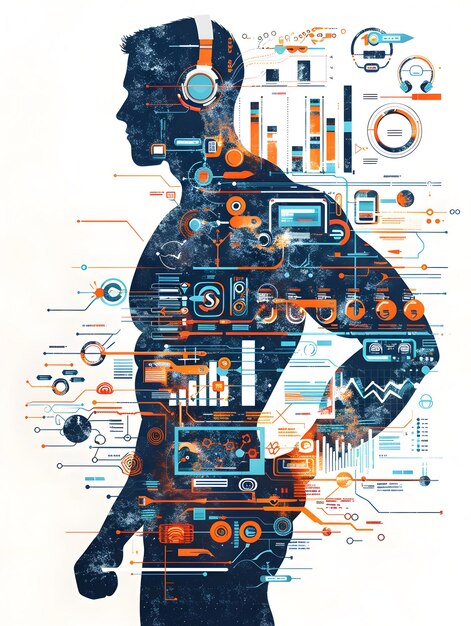AI in Online Learning: Personalizing Paths by 2025

Online learning platforms are rapidly integrating AI to create personalized educational experiences, ranging from adaptive content delivery and intelligent tutoring systems to predictive analytics and skills gap identification, ultimately aiming to enhance engagement and learning outcomes by 2025.
The landscape of education is in a constant state of evolution, and by 2025, a significant transformation will be underway, driven by artificial intelligence. Discover how online learning platforms are integrating AI to personalize learning paths in 2025, reshaping how individuals acquire knowledge and skills.
The Dawn of Adaptive Learning Environments
The integration of AI into online learning is not merely an enhancement; it heralds a new era of adaptive learning environments. These sophisticated systems move beyond static curricula, tailoring educational content and methodologies to each student’s unique needs, pace, and learning style. By analyzing vast amounts of data, AI algorithms can identify patterns that human instructors might miss, offering insights into engagement levels, comprehension, and potential areas of struggle.
One of the core promises of AI in education is its ability to create truly personalized learning paths. Traditional classrooms, even online ones, often struggle with the diversity of student needs. AI, however, can act as a tireless, individualized tutor, adapting in real time to the student’s performance and preferences. This means that a student struggling with a particular concept can receive additional resources and alternative explanations, while another who has mastered it can swiftly move on to more advanced material.
Understanding Adaptive Algorithm Mechanics
Adaptive algorithms are at the heart of personalized learning. These complex systems don’t just follow a predefined script; they learn and evolve with each interaction. Machine learning models analyze student responses, time spent on tasks, and even emotional states (through subtle cues) to adjust the learning trajectory dynamically. This continuous feedback loop ensures that the learning experience remains challenging but not overwhelming.
- Data Collection: Gathering student performance, engagement metrics, and behavioral patterns.
- Pattern Recognition: Identifying individual strengths, weaknesses, and preferred learning styles.
- Content Curation: Recommending relevant materials (videos, articles, exercises) in real-time.
The beauty of this approach lies in its scalability. What once required a dedicated human tutor for each student can now be partially automated, making high-quality personalized education accessible to a much broader audience. By 2025, these adaptive systems will be more ubiquitous, driven by advancements in natural language processing (NLP) and predictive analytics.
Furthermore, the data generated by these adaptive platforms offers valuable insights for educators and content creators. They can see which lessons are most effective, where students consistently stumble, and how different types of content impact learning outcomes. This allows for continuous improvement of educational materials, creating a virtuous cycle of data-driven refinement.
Intelligent Tutoring Systems and Conversational AI
Imagine having a tutor who is always available, endlessly patient, and possesses an encyclopedic knowledge of almost any subject. This is the promise of intelligent tutoring systems (ITS) powered by AI. Unlike simple chatbots, these systems are designed to understand complex questions, provide detailed explanations, and even engage in Socratic dialogue to guide students toward deeper understanding. By 2025, ITS will be more sophisticated, leveraging advanced natural language processing (NLP) to offer near human-level interaction.
These systems can analyze student responses for not just correctness but also for conceptual errors, offering targeted feedback that addresses the root of the misunderstanding. They can identify when a student is stuck and offer hints or alternative approaches without simply giving away the answer. This fosters a more robust learning process where students are encouraged to think critically and problem-solve.
Role of Natural Language Processing in ITS
Natural Language Processing (NLP) is the backbone of effective conversational AI in educational settings. It allows these systems to not only interpret student input but also to generate articulate, contextually relevant responses. As NLP continually improves, so does the fidelity and utility of ITS.
- Semantic Analysis: Understanding the meaning behind student questions and answers.
- Emotional Tone Detection: Identifying frustration or confusion to adjust teaching strategy.
- Personalized Feedback Generation: Crafting responses that resonate with the individual student’s query.
Beyond traditional tutoring, conversational AI is also being integrated into language learning platforms, providing students with opportunities to practice speaking and writing in a low-pressure, supportive environment. These AI companions can correct pronunciation, grammar, and even offer cultural insights, making language acquisition more immersive and effective.
The evolution of AI in this space also extends to accessibility. For students with learning disabilities or those who require specific accommodations, ITS can be tailored to meet their unique needs, offering auditory, visual, or textual supports as required. This expands the reach of quality education to a demographic that might otherwise face significant barriers in traditional settings.
Predictive Analytics and Early Intervention
One of the most powerful applications of AI in online learning platforms by 2025 will be its capacity for predictive analytics. By analyzing historical data and current student performance, AI can identify students at risk of falling behind or disengaging before problems escalate. This proactive approach allows educators and platforms to intervene early, offering targeted support and resources that can dramatically improve retention rates and academic success.
The ability to predict potential issues is invaluable. Instead of waiting for a student to fail an exam or drop out, AI can flag warning signs such as declining engagement, missed assignments, or consistent struggles with specific topics. This early warning system enables a shift from reactive problem-solving to proactive support, creating a more nurturing and effective learning environment.
Key Indicators for Risk Assessment
AI models leverage a variety of data points to assess student risk. These indicators are continuously monitored and analyzed to provide a comprehensive picture of each student’s academic standing and engagement levels.
- Engagement Metrics: Time spent on platform, participation in discussions, frequency of logins.
- Performance Data: Quiz scores, assignment grades, completion rates across courses.
- Behavioral Patterns: Procrastination habits, skipped modules, difficulty with prerequisite material.
Early intervention can take many forms, from automated notifications and recommended resources to direct outreach from instructors or academic advisors. The goal is not just to prevent failure but to optimize the learning experience for every student. This level of personalized support, once a luxury in education, is becoming a standard expectation with the advancement of AI.

Moreover, predictive analytics can help refine course design. By identifying common pitfalls or areas where a large number of students struggle, platform developers and content creators can adjust their offerings to be more effective from the outset, improving the educational experience for future cohorts.
Automated Content Curation and Creation
The sheer volume of information available online can be overwhelming for learners. AI, by 2025, will play an increasingly critical role in automating content curation and even assisting in content creation. This means that online learning platforms can offer highly relevant, up-to-date, and diverse learning materials tailored to individual learning paths without extensive manual effort.
AI algorithms can scour the web and vast digital libraries to find the most pertinent articles, videos, simulations, and interactive exercises. This not only saves educators immense time but also ensures that students have access to a rich and varied pool of resources. The algorithms can filter content based on complexity, relevance, and even pedagogical effectiveness, providing a stream of optimized learning materials.
AI in Dynamic Content Generation
Beyond curation, AI is also progressing towards generating new learning content. This includes creating personalized quizzes, practice problems, and even drafting explanatory texts based on specific learning objectives and student performance gaps.
- Quiz Generation: Automatically creating assessment questions based on course material and student comprehension.
- Adaptive Explanations: Generating varied explanations and examples for difficult concepts.
- Simulation Design: Assisting in the creation of interactive simulations and virtual labs.
This capability holds immense potential for rapid course development and customization. Imagine a new scientific discovery: AI could quickly distill relevant information and integrate it into existing curricula, ensuring that learning materials remain current. This agility is crucial in fast-evolving fields like technology and medicine.
However, human oversight remains vital. While AI can curate and generate content, the nuance, creativity, and ethical considerations often require human input. The role of educators will likely shift from primary content creators to expert curators and guides, leveraging AI tools to enhance their effectiveness and focus on higher-level pedagogical strategies.
Assessing Skills and Identifying Gaps
In a rapidly changing job market, identifying and addressing skills gaps is paramount. Online learning platforms, powered by AI, are becoming sophisticated tools for not only delivering knowledge but also for precisely assessing a learner’s current skill set and mapping it against desired competencies. By 2025, these platforms will offer robust methodologies for continuous skill assessment and personalized gap analysis.
AI-driven assessments go beyond traditional multiple-choice tests. They can analyze project work, code, essays, and even simulated performance to provide a holistic view of a student’s capabilities. This granular understanding allows for the creation of hyper-personalized recommendations for further learning, ensuring that individuals develop the exact skills they need for career advancement or personal growth.
Advanced Skill Gap Analysis
The magic of AI in this area lies in its ability to connect disparate data points. It can compare a learner’s performance across various courses and activities to established industry benchmarks, identifying precise areas where skills need to be developed or reinforced. This provides a clear roadmap for learners.
- Competency Mapping: Aligning acquired knowledge and abilities with industry-recognized skill frameworks.
- Performance Diagnostics: Pinpointing specific skill deficiencies through detailed analysis of output.
- Personalized Remediation: Recommending tailored modules or courses to bridge identified gaps.

This capability is particularly transformative for professional development and corporate training. Companies can leverage these platforms to upskill their workforce efficiently, ensuring they remain competitive in a dynamic economic landscape. Individuals, too, can take control of their career trajectories, proactively acquiring skills that are in high demand.
The feedback generated by these AI systems is not just about what a student got wrong, but *why*. It can explain conceptual misunderstandings, highlight patterns in errors, and suggest specific practice exercises to target those issues. This moves beyond simple grading to truly diagnostic assessment, a hallmark of effective learning.
Ethical Considerations and Future Outlook
While the integration of AI into online learning platforms offers unprecedented opportunities, it also raises important ethical considerations that must be carefully addressed as we approach 2025. Issues such as data privacy, algorithmic bias, and the balance between personalization and human interaction require careful navigation to ensure AI serves as a beneficial partner in education.
Data privacy is paramount. AI systems rely on vast amounts of student data, from performance metrics to behavioral patterns. Ensuring this data is collected, stored, and used responsibly, with transparency and consent, is crucial. Learners must trust that their personal information is protected and used solely for educational enhancement.
Addressing Algorithmic Bias
Algorithmic bias is another significant concern. If the data used to train AI models reflects existing societal biases, the personalized learning paths generated by these systems could inadvertently perpetuate inequities. Developers and educators must actively work to audit and mitigate bias in AI algorithms to ensure fair and equitable educational opportunities for all students.
- Data Diversity: Training AI models on diverse and representative datasets.
- Regular Auditing: Continuously checking algorithms for unintended biases and discriminatory outcomes.
- Transparency: Explaining how AI recommendations are made to foster trust and accountability.
The future of AI in online learning is not about replacing human educators but augmenting their capabilities. AI can handle the repetitive, data-intensive tasks, freeing up human instructors to focus on mentoring, fostering creativity, and addressing complex emotional and social needs that only humans can truly understand. The synergy between AI and human intelligence holds the key to a truly enriched learning experience.
By striking the right balance between AI-driven personalization and human guidance, online learning platforms can create dynamic, engaging, and ethically sound educational environments that prepare learners for success in an ever-changing world. The journey towards this future is ongoing, requiring continuous innovation, ethical reflection, and collaboration between technologists and educators.
| Key Feature | Brief Description |
|---|---|
| 🚀 Adaptive Learning | AI tailors content and pace to individual student needs and styles. |
| 🧠 Intelligent Tutoring | Conversational AI systems provide personalized feedback and explanations. |
| 🔍 Predictive Analytics | AI identifies at-risk students for early intervention and support. |
| 🛠️ Skill Gap Identification | Platforms assess competencies and recommend targeted learning paths. |
Frequently Asked Questions About AI in Online Learning
AI personalizes learning paths by analyzing student data, including performance, engagement, and learning styles. It then dynamically adjusts course content, difficulty levels, and recommended resources to match each individual’s needs, ensuring a tailored and effective educational journey. This adaptive approach maximizes comprehension and retention for diverse learners.
Intelligent tutoring systems (ITS) are AI-powered tools designed to provide individualized instruction and feedback, much like a human tutor. They leverage natural language processing to understand student queries, offer detailed explanations, and guide learners through complex topics, making learning more interactive and accessible around the clock.
Yes, AI can significantly aid in predicting student success or potential failure through predictive analytics. By analyzing historical data and current student engagement metrics, AI algorithms can identify warning signs early on, allowing educators to intervene proactively and offer targeted support to students who might be at risk of falling behind or disengaging.
AI automates content curation by scanning vast digital repositories to find relevant and high-quality learning materials such as articles, videos, and simulations. It then filters and recommends this content based on the student’s learning path, subject matter, and current understanding, ensuring a rich and personalized resource library. This saves time and keeps content updated.
The main ethical concerns with AI in education revolve around data privacy, algorithmic bias, and the potential impact on human interaction. Ensuring transparency in data usage, actively mitigating biases in AI models, and preserving the critical role of human educators are vital to using AI responsibly and equitably in learning environments.
The Evolving Horizon of Online Education
The integration of AI into online learning platforms is not a fleeting trend but a fundamental shift towards a more effective, personalized, and accessible educational future. By 2025, from adaptive learning environments and intelligent tutoring systems to predictive analytics and automated content curation, AI will have fundamentally reshaped how knowledge is imparted and acquired. While challenges such as ethical considerations and algorithmic bias remain, the potential for AI to democratize quality education and empower individual learners is immense. The synergy between advanced technology and human pedagogical expertise promises an era where learning is truly tailored to each student’s unique journey, preparing them more effectively for the complexities of the modern world. This ongoing evolution will continue to redefine the boundaries of what is possible in education.





